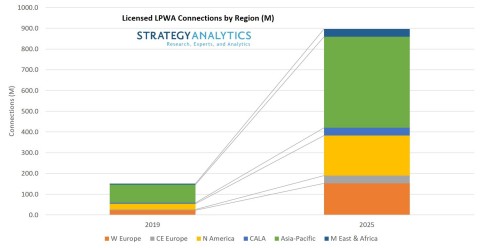BOSTON--(BUSINESS WIRE)--Strategy Analytics forecasts that licensed low power LPWA connections will grow to just short of 900m connections by 2025, significantly outstripping unlicensed LPWA connections over the same period, despite a slow start outside China, according to the Strategy Analytics IoT Strategies service report, “IoT Licensed Low Power Cellular Connections by Vertical”.
Many IoT applications do not require high bandwidth or ultra-low latency to function effectively. For this reason, 2G technologies still remain effective for a number of IoT applications. As the world pivots to 5G, low power solutions are also evolving to meet the needs of IoT. 4G LTE has evolved to support Cat 0 and Cat 1, but in 3GPP Release 13 standard, defined in 2016/2017, specific versions of LTE were defined that allowed for secure, low power use of LTE for IoT applications, namely LTE M and Narrowband IoT (NB‑IoT).
Andrew Brown, Executive Director of Enterprise and IoT Research at Strategy Analytics, said: “There are now over 92 NB IoT and over 36 LTE M networks and the number is growing all the time, with multiple service providers and module OEMs supporting both technologies. With roaming issues effectively being resolved around NB IoT, the future appears positive.”
“While NB IoT has emerged as the dominant technology, driven by huge infrastructure projects in China, strong in-building coverage, very low cost and long battery life, LTE M will continue to play an important role in applications with a significant downlink requirements and/or voice support, as well as FOTA (Firmware over the air) support. As 2G and 3G networks are phased out, licensed low power technologies operating on 4G and 5G networks will be pivotal in IoT deployments. NB IoT and Cat M will be covered by 5G and will naturally become the technology of choice for mMTC (Massive Machine-type Communications) in 5G. 5G NR (New Radio) is designed to support diverse deployment models. It is likely that from the start of 5G NR, the 3GPP will allow LTE M and NB IoT transmissions to be placed directly into the 5G NR frequency band. This simply requires core network RAN support. With cellular networks already in place, we believe the opportunity for these technologies are extremely viable in the long term,” Brown added.
The full report, “IoT Licensed Low Power Cellular Connections by Vertical”, assesses the opportunities in the licensed LPWA market, covering low power licensed spectrum IoT cellular connections (NB IoT and LTE M) by year, by vertical industry. It is published by Strategy Analytics.
Source: Strategy Analytics, Inc.
#SA_IoT
About Strategy Analytics
Strategy Analytics, Inc. is a global leader in supporting companies across their planning lifecycle through a range of customized market research solutions. Our multi-discipline capabilities include: industry research advisory services, customer insights, user experience design and innovation expertise, mobile consumer on-device tracking and business-to-business consulting competencies. With domain expertise in: smart devices, connected cars, intelligent home, service providers, IoT, strategic components and media, Strategy Analytics can develop a solution to meet your specific planning need. For more information, visit us at www.strategyanalytics.com
For more information about Strategy Analytics
IoT Strategies: Click here




